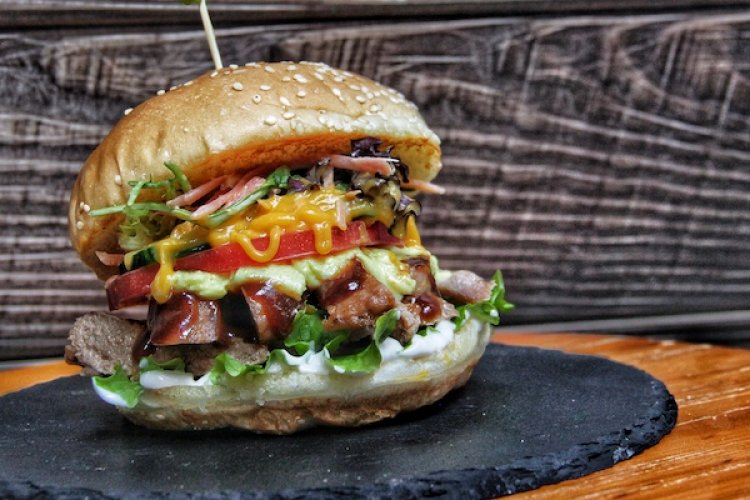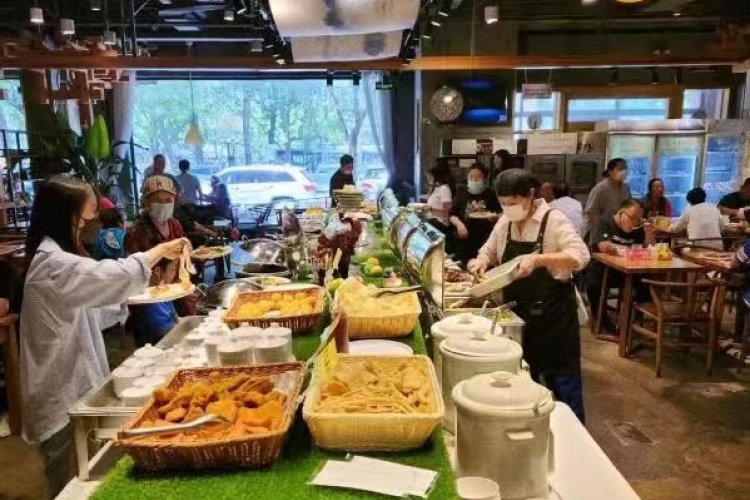Kyoto on a Plate: Ebisu Teppanyaki Debuts Set Inspired by Japanese Buddhist Vegetarian Traditions
“Irasshaimase!” shouts Mori (pronounced mao-ray), as I enter his restaurant’s small and unassuming space on Maizidian Road. Hidden in plain sight and tucked away in the shadows of Ichibangai East Building’s ground floor, Ebisu Teppan-yaki has launched a new set menu: Shojin Kaiseki.
I’m the first customer of the night to arrive, but despite the early hour, trickles of live music cascade down from Tokyo Lounge on the second floor. Opened in October 2022, the restaurant is compact and sleek, with a teppan (a grill made of cast iron) separating the chef from the customers.

I compliment the head chef on his kimono, only to be given an impromptu lesson on Japanese culture. “This is a hanten,” says Mori, “not a kimono.” He pours green tea into a ceramic mug and asks if I’m ready to begin eating.
The Hassun (appetizer platter) is the first of nine courses to be served, and as expected at a Japanese restaurant of this caliber, the presentation is meticulous and flawless: edamame beans marinated in soy sauce, radish with plum sauce, sugar snap peas dusted in a savory spice mix and a single cube of dried tofu on a skewer that rests on a perilla leaf.
Suimono (clear soup) follows and while the soup tastes alarmingly fishy, I’m gently reminded that everything on this set menu is 100% vegan. The broth tastes deeply of the ocean, with a salty umami punch that refuses to go unnoticed. The lotus root cake that sits submerged in the middle is delicate and mild but soaks up flavor well when dismembered by chopsticks.

The Otsukuri (raw dish) course is next and I’m surprised to learn that both yuba and konjac are often used in sashimi dishes, not as a substitute for raw fish or seafood, but as an additional option for diners. The yuba skin is slick and moist; it dangles from my chopsticks when I smear it in neon-green wasabi and dab it in the soy sauce. While perfectly pleasant with the perilla leaf or flossed radish that is provided, the flavor profile turns up to eleven when dipped in the aforementioned sauces.
“Modern Japanese people don’t eat shojin kaiseki on a daily basis, but it originates from Kyoto and that’s where I grew up. I frequently came into contact with this type of cuisine as we have many Buddhist monks in my hometown and this type of food is very popular,” says Mori. He refills my green tea with a smile and dashes back into the kitchen.

“Japanese people did not really eat meat until around 150 years ago, so there are many vegetable-only menus at traditional restaurants serving Japanese (or Wasoku) cuisine, although vegans should look out for dashi,” he adds. “Kaiseki cuisine pursues the ultimate in nutritional balance; the amount of protein, carbohydrates, fats and vitamins is very important.”
Kawari-bachi (fried dish) is next and of all the dishes on the set menu, this is the one I’m most apprehensive about. As a lifelong sufferer of fungi phobia, I nibble on the stems and caps before committing to a full piece. Grilled in vegan butter and seasoned simply, the mushrooms are seared to perfection and entirely edible. I’m somewhat shocked at how much I enjoy them and Mori smiles proudly.

The Yakimono (grilled dish) follows, and as someone not overly familiar with konjac, the texture is somewhat alien. It’s equal parts gummy and viscous — both of which are not flattering adjectives to describe food — but it’s also not unpleasant. The gravy holds this dish together and although slightly brackish, the savory bite is delightful and lingers into the next dish.
Agemono (deep-fried dish) is the sixth dish and is aesthetically pleasing, to say the least. A wedge of eggplant rests on the traditional tofu agedashi, while crispy flakes of seaweed garnish the top. Purple to the point of being almost black, this deep-fried eggplant looks remarkably like fish skin. The sauce is stewed with konbu, which adds to the fishy facade. The eggplant’s crisp shell does not conceal a soggy interior, instead, it is delicious and fibrous even when submerged in sauce. My chopsticks penetrate the flaky exterior of the tofu, exposing a white underbelly that floats on the surface.

At lucky number seven, the Tome-wan (last soup) is an impeccably seasoned bowl of miso soup that is delightfully cloudy when stirred. Gohan (cooked rice) is eighth, served alongside the soup in a ceramic pot. This tofu fried rice replicates the taste and texture of a fried egg exceptionally well, and although Uncle Roger might protest at the substitution, the crispy bean curd imparts a delectable mouthfeel. It is immensely satisfying.
Kanmi (sweetness) is served last and concludes the set menu. “Do you read manga?” inquires Mori. “Doraemon’s favorite food is Dorayaki.” Two exquisitely formed miniature pancakes wrap around sweetened red bean paste and are served alongside yuzu sherbet. The sweet-and-sour combination is the perfect way to wrap things up.

To describe the presentation as painstakingly precise is still an understatement. Each of the nine courses is intricately arranged with creative flair, but beyond just the visual appeal, to partake in this set menu is to embark on a sensory adventure.
The Shojin Kaiseki set menu is RMB 280 and must be reserved one day in advance, but the restaurant’s standard menu is already very vegan-friendly. “A customer once asked me to make something vegan and I had to improvise with whatever ingredients I had in stock,” says Mori. “After similar requests, we came up with a plant-based menu that has since expanded into what we have today.”
The current meatless menu is more than just an afterthought and consists of two pages of Japanese, Italian, Western, and Indian dishes. Italian gnocchi (RMB 48) are especially popular, not just at Ebisu, but also in Japan. “In nearly every Murakami novel, there is a scene at an Italian restaurant or someone making pasta sauce,” says Mori.
Ebisu Teppanyaki 惠比寿铁板烧
1/F, Ichibangai East Bldg, 78 Maizidian Street, Chaoyang District
朝阳区麦子店街78号一番街横丁一层
READ: More Than O Le at Ori Sake & Food
Images: RJ Fry







